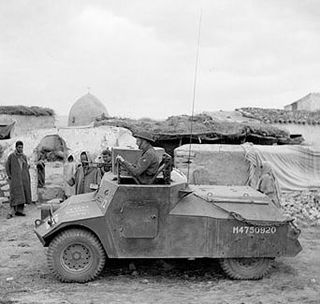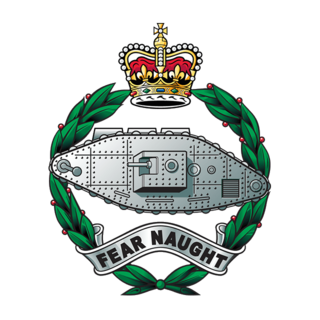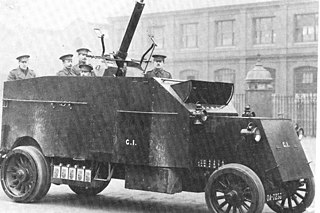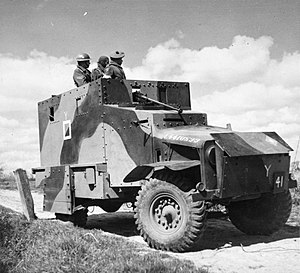
The Universal Carrier, also known as the Bren Gun Carrier and sometimes simply the Bren Carrier from the light machine gun armament, is a common name describing a family of light armoured tracked vehicles built by Vickers-Armstrongs and other companies.

AEC Armoured Car is the name of a series of British heavy armoured cars built by the Associated Equipment Company (AEC) during the Second World War.

The Ordnance QF 2-pounder, or simply "2 pounder gun", was a 40 mm (1.575 in) British anti-tank gun and vehicle-mounted gun employed in the Second World War.

The Morris Commercial C8 FAT, commonly known as a Quad, is an artillery tractor used by the British and Commonwealth forces during the Second World War. It was used to tow field artillery pieces, such as the 25-pounder gun-howitzer, and anti-tank guns, such as the 17-pounder.
Bedford Vehicles, usually shortened to just Bedford, was a brand of vehicle manufactured by Vauxhall Motors, then a subsidiary of multinational corporation General Motors. Established in April 1931, Bedford Vehicles was set up to build commercial vehicles. The company was a leading international lorry brand, with substantial export sales of light, medium, and heavy lorries throughout the world.

An artillery tractor, also referred to as a gun tractor, is a specialized heavy-duty form of tractor unit used to tow artillery pieces of varying weights and calibres. It may be wheeled, tracked, or half-tracked.

Armoured Carrier, Wheeled, Indian Pattern (ACV-IP), known also as Indian Pattern Carrier or other similar names, was an armoured car produced in India during the Second World War. It was typically armed with a Bren light machine gun. Those produced by Tata Locomotives were called "Tatanagars" after the location of the works. 4,655 were produced, used by Indian units in the Far East and Mediterranean and Middle East Theatre, typically in divisional reconnaissance regiments.

Morris Light Reconnaissance Car (LRC) was a British light armoured car for reconnaissance use produced by Morris Motors Limited and used by the British during the Second World War.

Standard Car 4x2, or Car Armoured Light Standard, better known as the Beaverette, was a British improvised armoured car produced during the Second World War.

Portée describes the practice of carrying an artillery piece on a truck which can be fired from the vehicle or quickly dismounted and fired from the ground. The term is most often used to describe anti-tank equipments used by the British, Commonwealth and imperial forces in the Western Desert Campaign of the Second World War. Modern terms for mounting weapons on vehicles are technical or gun truck.

During the First World War, sixteen American Peerless trucks were modified by the British to serve as armoured cars. These were relatively primitive designs with open backs, armed with a Pom-pom gun and a machine gun, and were delivered to the British Army in 1915. They were used also by the Imperial Russian Army as self-propelled anti-aircraft guns.
The 8th Support Group was a brigade-sized military formation of the British Army during the Second World War, attached to the 8th Armoured Division, composed of Regular Army units. The Support Group as part of 8th Armoured Division was sent to North Africa but never saw active service as a complete formation. As the division could not be provided with a lorried infantry brigade, it was broken up and was finally disbanded in Egypt on 1 January 1943.

Canadian Military Pattern (CMP) trucks were mutually coherent ranges of military trucks, made in large numbers, in several classes and numerous versions, by Canada's branches of the U.S. 'Big Three' auto-makers during World War II, compliant to British Army specifications, primarily intended for use in the armies of the British Commonwealth allies, but also serving in other units of the British Empire.

The Bison was an improvised fighting vehicle frequently characterised as a mobile pillbox. Bisons were produced in Britain during the invasion crisis of 1940-1941. Based on a number of different lorry chassis, it featured a fighting compartment protected by a layer of concrete. Bisons were used by the Royal Air Force (RAF) to protect aerodromes and by the Home Guard. They acquired the generic name "Bison" from their main manufacturer.

The Bedford OY is an army lorry (truck) built by Bedford for the British Armed Forces and introduced in 1939. It was based on Bedford's O-series commercial vehicles with a modified front end and single rear tyres. It was designed for a 3-ton payload. The OYD was a general service vehicle, while the OYC was a tanker version for carrying water or petrol. These vehicles were widely used during, and after, World War II but were later superseded by the Bedford RL.

The Malta Tanks was a unit designation for an independent Royal Tank Regiment (RTR) unit made of a mixture of British tank types deployed to Malta in World War 2.

The Bedford MW was a general service truck used by the British Armed Forces during the Second World War.

The Pierce-Arrow armoured AA lorry was a self-propelled anti-aircraft carrier mounting a QF 2-pounder AA "pom-pom" gun, it was used by the Royal Marine Artillery during the First World War.

The 12th Motorised Brigade (South Africa) was a South African brigade-level infantry unit that served with the Allies in the Italian Campaign of World War II under the 6th South African Armoured Division. It was the first South African unit to enter combat in Italy. The unit was activated in 1943 and had generally deactivated by 8 May 1945.


















